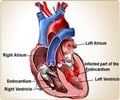A report in the September 28 issue of Archives of Internal Medicine, one of the JAMA/Archives journals says that hospital-at-home care may be a practical alternative to traditional hospital inpatient care for patients with acutely decompensated chronic heart failure.
Nearly 7 million Europeans and 5 million North Americans are affected by chronic heart failure, a progressive and disabling syndrome, according to background information in the article. Hospitalization for chronic heart failure for older patients has increased and occurs in 2 percent to 3 percent of patients over age 85 every year. In the United States, decompensation (worsening) of chronic heart failure leads to more than 1 million hospital admissions per year and a 50 percent risk of subsequent hospitalization within six months of discharge. "Although the hospital is the standard venue for providing acute medical care, it may be hazardous for older persons, who commonly experience iatrogenic illness [complications due to treatment], functional decline and other adverse events."Vittoria Tibaldi, M.D., Ph.D., and colleagues at the University of Torino, San Giovanni Battista Hospital, Torino, Italy, compared the effectiveness of a physician-led hospital-at-home service for elderly patients with acute decompensation of chronic heart failure with traditional hospital inpatient care. Patients age 75 or older with decompensation of chronic heart failure were randomly assigned to either a general medical ward (53 patients) or to the Geriatric Home Hospitalization Service (48 patients) between April 2004 and April 2005. The Geriatric Home Hospitalization Service provided diagnostic and therapeutic treatments by hospital health care professionals in the home of the patient.
At six months, 15 percent of all patients had died, with no significant differences between the two groups. "The number of subsequent hospital admissions was not statistically different in the two groups, but the mean [average] time to first additional admission was longer for the Geriatric Home Hospitalization Service patients (84.3 days vs. 69.8 days). Only the Geriatric Home Hospitalization Service patients experienced improvements in depression, nutritional status and quality-of-life scores," the authors write.
"Recent trends in health care favor alternatives to traditional acute care in hospitals. These trends include advancement in telehealth technologies and increased demand for treatment at home," the authors conclude. "Further development of hospital-at-home care will require additional research and dedicated resources to support dissemination."
Source-Eurekalert
RAS














